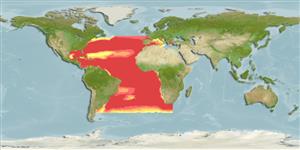Environment: milieu / climate zone / depth range / distribution range
Ecologia
marinhas; oceanódromo (Ref. 51243); intervalo de profundidade 0 - 150 m (Ref. 43), usually 0 - 100 m (Ref. 55219). Subtropical; 22°C - ? (Ref. 12451); 47°N - 45°S, 99°W - 27°E (Ref. 55219)
Atlantic Ocean: roughly from 45°N to 45°S in the southwestern Atlantic and 35°S in the southeastern Atlantic. Records from the Mediterranean Sea, and from Bretagne, France seem to correspond to a few straying individuals. Classified as 'reduced' (Ref. 12451). It is unclear whether there are two separate stocks or a single population in the Atlantic. Highly migratory species.
Comprimento de primeira maturação / Tamanho / Peso / Idade
Maturity: Lm 164.0, range 130 - ? cm
Max length : 300 cm TL macho/indeterminado; (Ref. 4770); common length : 210 cm TL macho/indeterminado; (Ref. 5217); peso máx. publicado: 82.5 kg (Ref. 43)
Espinhos dorsais (total): 0; Raios dorsais (total): 43-52; Espinhos anais 0; Raios anais : 17 - 23. Blue-black above, silvery white and splattered with brown on the sides, silvery white below; sometimes with more than 15 rows of obscure whitish stripes; 1st dorsal fin dark blue with black dots; 2nd dorsal fin dark blue; pectorals blackish brown, with tinges of silvery white in some specimens; pelvic fins blue-black with a black fin membrane; caudal fin blackish brown.
Usually above the thermocline. Its distribution varies seasonally, reaching higher latitudes in both the northern and southern hemispheres only during the respective warm seasons. Usually found in deep (over 100 m) blue water with surface temperatures over 22°C and salinities of 35 to 37 ppt. Currents of 0.5 to 2 knots occur over much of its habitat. Feeds on fishes and squids. Females grow larger (Ref. 4770). Flesh is of excellent quality. Marketed fresh and frozen.
Ciclo de vida ou comportamento de acasalamento
Maturidade | Reprodução | Desova | Ovos | Fecundidade | Larvas
Migrates into subtropical waters to spawn, with peak spawning occurring in early summer. The spawning areas are found in deep and blue oceanic waters, generally at high temperatures ranging from 20° to 29°C except in the southern Atlantic gyrals, and high surface salinities (over 35 ppt).
Nakamura, I., 1985. FAO species catalogue. Vol. 5. Billfishes of the world. An annotated and illustrated catalogue of marlins, sailfishes, spearfishes and swordfishes known to date. FAO Fish. Synop. 125(5):65p. Rome: FAO. (Ref. 43)
Status na Lista Vermelha da UICN (Ref. 130435)
Ameaça para os humanos
Harmless
Uso pelos humanos
Pescarias: pouco comercial; peixe esportivo: sim
Mais informação
ReferênciasAquaculturaPerfil para aquaculturaEstirpesGenéticaElectrophoresesHereditariedadeDoençasProcessamentoNutrientsConversão de massa
Ferramentas
Relatórios especiais
Baixar XML
Fontes da internet
Estimates based on models
Preferred temperature (Ref.
123201): 15.7 - 27.9, mean 25.1 °C (based on 1614 cells).
Índice de diversidade filogenética (Ref.
82804): PD
50 = 0.7505 [Uniqueness, from 0.5 = low to 2.0 = high].
Bayesian length-weight: a=0.00447 (0.00193 - 0.01034), b=3.14 (2.94 - 3.34), in cm total length, based on LWR estimates for this (Sub)family-body shape (Ref.
93245).
Nível Trófico (Ref.
69278): 4.5 ±0.4 se; based on diet studies.
Generation time: 1.9 ( na - na) years. Estimated as median ln(3)/K based on 1
growth studies.
Resiliência (Ref.
120179): médio(a), tempo mínimo de duplicação da população 1,4 - 4,4 anos (K=0.58; assuming tm >=2).
Fishing Vulnerability (Ref.
59153): Moderate vulnerability (41 of 100).
Climate Vulnerability (Ref.
125649): High vulnerability (62 of 100).
Nutrients (Ref.
124155): Calcium = 38 [16, 74] mg/100g; Iron = 1.1 [0.6, 2.1] mg/100g; Protein = 19.9 [18.6, 21.1] %; Omega3 = 0.225 [0.114, 0.444] g/100g; Selenium = 46.4 [22.1, 100.3] μg/100g; VitaminA = 4.21 [1.14, 15.31] μg/100g; Zinc = 0.34 [0.22, 0.53] mg/100g (wet weight);
